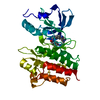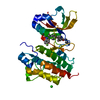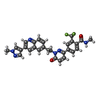+ Open data
Open data
- Basic information
Basic information
| Entry | Database: PDB / ID: 7y4u | ||||||
|---|---|---|---|---|---|---|---|
| Title | Crystal structure of cMET kinase domain bound by compound 9Y | ||||||
 Components Components | Hepatocyte growth factor receptor | ||||||
 Keywords Keywords | TRANSFERASE/INHIBITOR / TRANSFERASE INHIBITOR / TRANSFERASE / TRANSFERASE-INHIBITOR complex | ||||||
| Function / homology |  Function and homology information Function and homology informationhepatocyte growth factor receptor activity / negative regulation of guanyl-nucleotide exchange factor activity / Drug-mediated inhibition of MET activation / MET activates STAT3 / negative regulation of hydrogen peroxide-mediated programmed cell death / MET interacts with TNS proteins / MET Receptor Activation / endothelial cell morphogenesis / semaphorin receptor activity / MET receptor recycling ...hepatocyte growth factor receptor activity / negative regulation of guanyl-nucleotide exchange factor activity / Drug-mediated inhibition of MET activation / MET activates STAT3 / negative regulation of hydrogen peroxide-mediated programmed cell death / MET interacts with TNS proteins / MET Receptor Activation / endothelial cell morphogenesis / semaphorin receptor activity / MET receptor recycling / pancreas development / MET activates PTPN11 / MET activates RAP1 and RAC1 / Sema4D mediated inhibition of cell attachment and migration / MET activates PI3K/AKT signaling / negative regulation of stress fiber assembly / positive regulation of endothelial cell chemotaxis / negative regulation of Rho protein signal transduction / MET activates PTK2 signaling / branching morphogenesis of an epithelial tube / positive chemotaxis / negative regulation of thrombin-activated receptor signaling pathway / semaphorin-plexin signaling pathway / establishment of skin barrier / MET activates RAS signaling / Regulation of MITF-M-dependent genes involved in cell cycle and proliferation / phagocytosis / MECP2 regulates neuronal receptors and channels / positive regulation of microtubule polymerization / negative regulation of autophagy / liver development / basal plasma membrane / InlB-mediated entry of Listeria monocytogenes into host cell / excitatory postsynaptic potential / molecular function activator activity / receptor protein-tyrosine kinase / Negative regulation of MET activity / neuron differentiation / Constitutive Signaling by Aberrant PI3K in Cancer / cell migration / PIP3 activates AKT signaling / nervous system development / PI5P, PP2A and IER3 Regulate PI3K/AKT Signaling / RAF/MAP kinase cascade / protein tyrosine kinase activity / protein phosphatase binding / postsynapse / receptor complex / cell surface receptor signaling pathway / cell surface / signal transduction / positive regulation of transcription by RNA polymerase II / extracellular region / ATP binding / identical protein binding / membrane / plasma membrane Similarity search - Function | ||||||
| Biological species |  Homo sapiens (human) Homo sapiens (human) | ||||||
| Method |  X-RAY DIFFRACTION / X-RAY DIFFRACTION /  SYNCHROTRON / SYNCHROTRON /  MOLECULAR REPLACEMENT / Resolution: 2.26 Å MOLECULAR REPLACEMENT / Resolution: 2.26 Å | ||||||
 Authors Authors | Qu, L.Z. / Chen, Y.H. | ||||||
| Funding support |  China, 1items China, 1items
| ||||||
 Citation Citation |  Journal: J.Med.Chem. / Year: 2022 Journal: J.Med.Chem. / Year: 2022Title: Discovery of D6808, a Highly Selective and Potent Macrocyclic c-Met Inhibitor for Gastric Cancer Harboring MET Gene Alteration Treatment. Authors: Wang, C. / Li, J. / Qu, L. / Tang, X. / Song, X. / Yang, F. / Chen, X. / Lin, Q. / Lin, W. / Zhou, Y. / Tu, Z. / Chen, Y. / Zhang, Z. / Lu, X. | ||||||
| History |
|
- Structure visualization
Structure visualization
| Structure viewer | Molecule:  Molmil Molmil Jmol/JSmol Jmol/JSmol |
|---|
- Downloads & links
Downloads & links
- Download
Download
| PDBx/mmCIF format |  7y4u.cif.gz 7y4u.cif.gz | 74.3 KB | Display |  PDBx/mmCIF format PDBx/mmCIF format |
|---|---|---|---|---|
| PDB format |  pdb7y4u.ent.gz pdb7y4u.ent.gz | 51.4 KB | Display |  PDB format PDB format |
| PDBx/mmJSON format |  7y4u.json.gz 7y4u.json.gz | Tree view |  PDBx/mmJSON format PDBx/mmJSON format | |
| Others |  Other downloads Other downloads |
-Validation report
| Summary document |  7y4u_validation.pdf.gz 7y4u_validation.pdf.gz | 835.7 KB | Display |  wwPDB validaton report wwPDB validaton report |
|---|---|---|---|---|
| Full document |  7y4u_full_validation.pdf.gz 7y4u_full_validation.pdf.gz | 840.6 KB | Display | |
| Data in XML |  7y4u_validation.xml.gz 7y4u_validation.xml.gz | 13.3 KB | Display | |
| Data in CIF |  7y4u_validation.cif.gz 7y4u_validation.cif.gz | 17.5 KB | Display | |
| Arichive directory |  https://data.pdbj.org/pub/pdb/validation_reports/y4/7y4u https://data.pdbj.org/pub/pdb/validation_reports/y4/7y4u ftp://data.pdbj.org/pub/pdb/validation_reports/y4/7y4u ftp://data.pdbj.org/pub/pdb/validation_reports/y4/7y4u | HTTPS FTP |
-Related structure data
| Related structure data |  7y4tC  8gvjC  6sd9S S: Starting model for refinement C: citing same article ( |
|---|---|
| Similar structure data | Similarity search - Function & homology  F&H Search F&H Search |
- Links
Links
- Assembly
Assembly
| Deposited unit | 
| ||||||||
|---|---|---|---|---|---|---|---|---|---|
| 1 |
| ||||||||
| Unit cell |
|
- Components
Components
| #1: Protein | Mass: 34842.320 Da / Num. of mol.: 1 / Fragment: kinase domain Source method: isolated from a genetically manipulated source Source: (gene. exp.)  Homo sapiens (human) / Gene: MET / Production host: Homo sapiens (human) / Gene: MET / Production host:  References: UniProt: P08581, receptor protein-tyrosine kinase |
|---|---|
| #2: Chemical | ChemComp-I94 / ~{ |
| #3: Water | ChemComp-HOH / |
| Has ligand of interest | Y |
-Experimental details
-Experiment
| Experiment | Method:  X-RAY DIFFRACTION / Number of used crystals: 1 X-RAY DIFFRACTION / Number of used crystals: 1 |
|---|
- Sample preparation
Sample preparation
| Crystal | Density Matthews: 2.9 Å3/Da / Density % sol: 57.63 % |
|---|---|
| Crystal grow | Temperature: 291 K / Method: vapor diffusion, hanging drop / pH: 7.8 / Details: 0.1 M HEPES (pH 7.8), 15-30% (v/v) PEG 8000 |
-Data collection
| Diffraction | Mean temperature: 100 K / Serial crystal experiment: N |
|---|---|
| Diffraction source | Source:  SYNCHROTRON / Site: SYNCHROTRON / Site:  SSRF SSRF  / Beamline: BL17U / Wavelength: 0.97915 Å / Beamline: BL17U / Wavelength: 0.97915 Å |
| Detector | Type: ADSC QUANTUM 1 / Detector: CCD / Date: Oct 18, 2021 |
| Radiation | Protocol: SINGLE WAVELENGTH / Monochromatic (M) / Laue (L): M / Scattering type: x-ray |
| Radiation wavelength | Wavelength: 0.97915 Å / Relative weight: 1 |
| Reflection | Resolution: 2.26→41.61 Å / Num. obs: 18081 / % possible obs: 90.2 % / Redundancy: 15.7 % / CC1/2: 1 / Net I/σ(I): 18.9 |
| Reflection shell | Resolution: 2.26→2.4 Å / Num. unique obs: 1953 / CC1/2: 0.91 |
- Processing
Processing
| Software |
| ||||||||||||||||||||||||||||||||||||||||||||||||||||||||
|---|---|---|---|---|---|---|---|---|---|---|---|---|---|---|---|---|---|---|---|---|---|---|---|---|---|---|---|---|---|---|---|---|---|---|---|---|---|---|---|---|---|---|---|---|---|---|---|---|---|---|---|---|---|---|---|---|---|
| Refinement | Method to determine structure:  MOLECULAR REPLACEMENT MOLECULAR REPLACEMENTStarting model: 6SD9 Resolution: 2.26→41.61 Å / SU ML: 0.3 / Cross valid method: THROUGHOUT / σ(F): 1.35 / Phase error: 29.19 / Stereochemistry target values: ML
| ||||||||||||||||||||||||||||||||||||||||||||||||||||||||
| Solvent computation | Shrinkage radii: 0.9 Å / VDW probe radii: 1.11 Å / Solvent model: FLAT BULK SOLVENT MODEL | ||||||||||||||||||||||||||||||||||||||||||||||||||||||||
| Displacement parameters | Biso max: 113.89 Å2 / Biso mean: 56.5179 Å2 / Biso min: 35.93 Å2 | ||||||||||||||||||||||||||||||||||||||||||||||||||||||||
| Refinement step | Cycle: final / Resolution: 2.26→41.61 Å
| ||||||||||||||||||||||||||||||||||||||||||||||||||||||||
| LS refinement shell | Refine-ID: X-RAY DIFFRACTION / Rfactor Rfree error: 0 / Total num. of bins used: 7
|
 Movie
Movie Controller
Controller



 PDBj
PDBj













